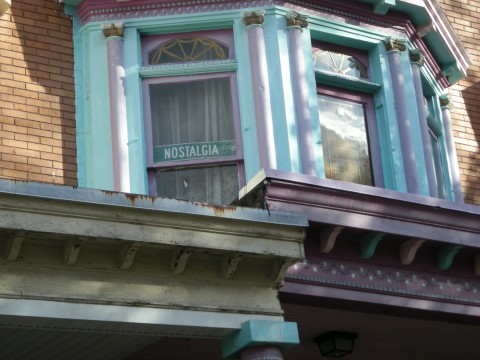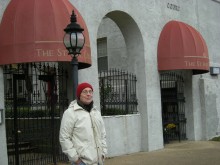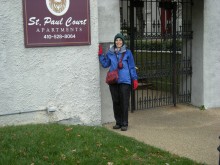
21
Feb

Window, Row House 2100 block Calvert St., Baltimore, MD
“From the Greek nostos, to return home and the Old English genesan, to survive,” the word nostalgia also denotes a “wistful or excessively sentimental yearning for return to or of some past period or irrecoverable condition.” Pilgrimage refers to “the journey of a pilgrim or wayfarer especially to a shrine or sacred place and the course of life on earth.” [Merriam-Webster’s Collegiate Dictionary, 11th edition].
Before returning from Washington, DC, to Washington State, Seelye and I retraced the neighborhood haunts of our courtship and first married life in Baltimore, MD. As now, we lived then on a threshold between university life and science, family and faith. Despite cloudy windy cold weather that warmed with the day, the Sunday morning drive sped us first to the Baltimore Episcopal Cathedral of the Incarnation, the seat of Maryland’s fourteenth bishop, Rt. Reverend Eugene Taylor Sutton. As canon, Eugene had signed me up as a volunteer in the National Cathedral Center for Prayer and Pilgrimage, November 28, 2006. On June 28, 20008 the National Cathedral filled with witnesses to the joyous consecration of this prayerful, bold-hearted bishop. As Bishop Claggett, Maryland’s first and first to be consecrated on American soil, was a slaveholder, Bishop Sutton’s call, with the election of the forty-fourth President of the United States, heralds a deep healing in our country.
Lacking a transept or crossing, the small, narrow Gothic Cathedral of the Incarnation teems with children and manifests careful loving intense use. To the right of the entrance the poignant chapel to Children of the Light, names the murdered youths of the city, thirty-five to that date. Two more the next week. A banner bearing bells and a satin ribbon for each teen or child drapes over the stair rail leading down to the Peace Chapel, Columbarium, and undercroft. There the dark wood floor is newly painted with a beautiful blue labyrinth. Everywhere the eye sees pictures, icons, windows, sensing the spirit of mindful, whole-hearted occupancy, and history.
Next we approached Johns Hopkins University, retracing Seelye’s old running route along San Martin Drive. Everywhere new buildings! Finding a parking spot near new Decker Court, a map pointed us to Latrobe Hall. The familiar end doorway allowed a glimpse of the same hallway leading in the past to the Hydraulics Laboratory. There Seelye had built wave tanks, paddles, stratified water with 100-pound bags of salt and prepared his thesis. Satisfied about the science, we could not find our way to St. Paul Street.
Few people braved the cold wind, but an angel appeared: a Nigerian-born security officer guided us through the 1963 familiar walkway, past the Merrick Barn theater to the entrance at 33rd Street. Two blocks east and turning south, there was our same rear porch with the trash chute, the courtyard with the lion head fixed to a new longer, wider green-painted wall, and a new wooden gazebo visible to the rear. Today the entry sports a handsome black iron grill gateway; flower pots fill the right side. The entry doors are painted red! Maroon awnings over each side of the gate and a big sign all announce St. Paul Court Apartments. The old A&P across the street is now an attractive independent Eddie’s Market. Next we strolled around the block along Calvert Street, noting that the alley where we rented our garage for $10 a month, is new built, but plenty of similar ones survive. Along Calvert Street I noted and photographed the sign depicted above: Nostalgia.
Returning along 31st Street to St. Paul we happened into Donna’s Restaurant on the corner for a tasty colorful lunch in a warm place. Waitress Julia arrived only two months ago, but enjoyed our story and attended us cheerfully. An intense happiness infused my partaking of the meal with Seelye. Communion. We walked past Seelye’s bachelor apartment, a studio with bay window on the ground floor of number 2125 St. Paul Street, around the block of gorgeous stone buildings and across St. Charles St. to the Baltimore Museum of Art.
A student of my father’s from California days, then a crystallographer at JHU, had given us membership as a wedding present. How we enjoyed trips there and renting pictures from the rental gallery. Now the City of Baltimore subsidizes BAM and the Walters Art Gallery so admission is free! To browse the uncrowded galleries ’twas very heaven.” The European paintings (remembered as inferior to the Boston Museum collections) sparkled, the British landscape drawings and watercolors lured, the Cone collection, remodeled in 2001, simply shone. Two independently wealthy sisters who mostly purchased directly from the artists and their travels, formed the single largest collection of Matisse works. Benefactor Joseph Epstein’s collection of European paintings struck me as choice. And, since our time, a trustee has donated eight exquisite miniature rooms. The New England sea captain’s salon has a tiny telescope a little rounder than a toothpick, pointed out the window. Squinting, you can see light through it! The one room of Chinese art is spaciously and informatively arrayed. Small, but distilled pleasure.
Such a car ride offers time for a particular intimacy: one does not look the other in the eye. The freedom from interruption fosters rumination and sharing thoughts.
“We may not have as much money for retirement as I hoped,” Seelye observed.
“Yes, my nest egg has dropped by a third. I have been thinking and praying about getting older. We have been blessed by wonderful experiences and travel in life. Three things money cannot buy: time, health, and friendships.”
Which brings me to fibrinogen. Created in the liver, the plasma protein circulates in the blood. When clotting is needed, with the catalytic action of the enzyme thrombin, fibrinogen forms the insoluble fibrous protein fibrin, forming clots. The molecule fibrinogen has served me faithfully as metaphor for friendship, especially created in response to life’s inevitable losses. As we prepared to marry, my mother died, and Seelye found our first apartment, applying in choosing his love for tall ceilings, windows for light and air, wood floors, workable kitchens and inviting bathrooms. Mourning my mother, that first summer in Baltimore, until we furnished the spare apartment, I suffered shin splints. I taught myself to plan, shop, and cook delicious and nutritious meals. Where my mother knew Prometheus, I invoked Hestia.
My father used to call me his little duck. In the 1980s I found in San Francisco’s Chinatown, a carved Chinese miniature ivory “looking-back” duck. Later, dropped from the mantel, the duck lost its head. Looking back is salutary on occasion, but not a way to live. “Seelye,” I said in the car driving home, “we could not know our journey from 1965 to today. No more can we tell what lies ahead. Beyond money, we can take care of our bodies, our minds, our spirits. As Palestine Patriarch Miles Sherrill used to intone, ‘Grow old along with me, the best is yet to be’.”


Seelye and Julie, 3120 St. Paul Street, Baltimore, MD. November 16, 2009